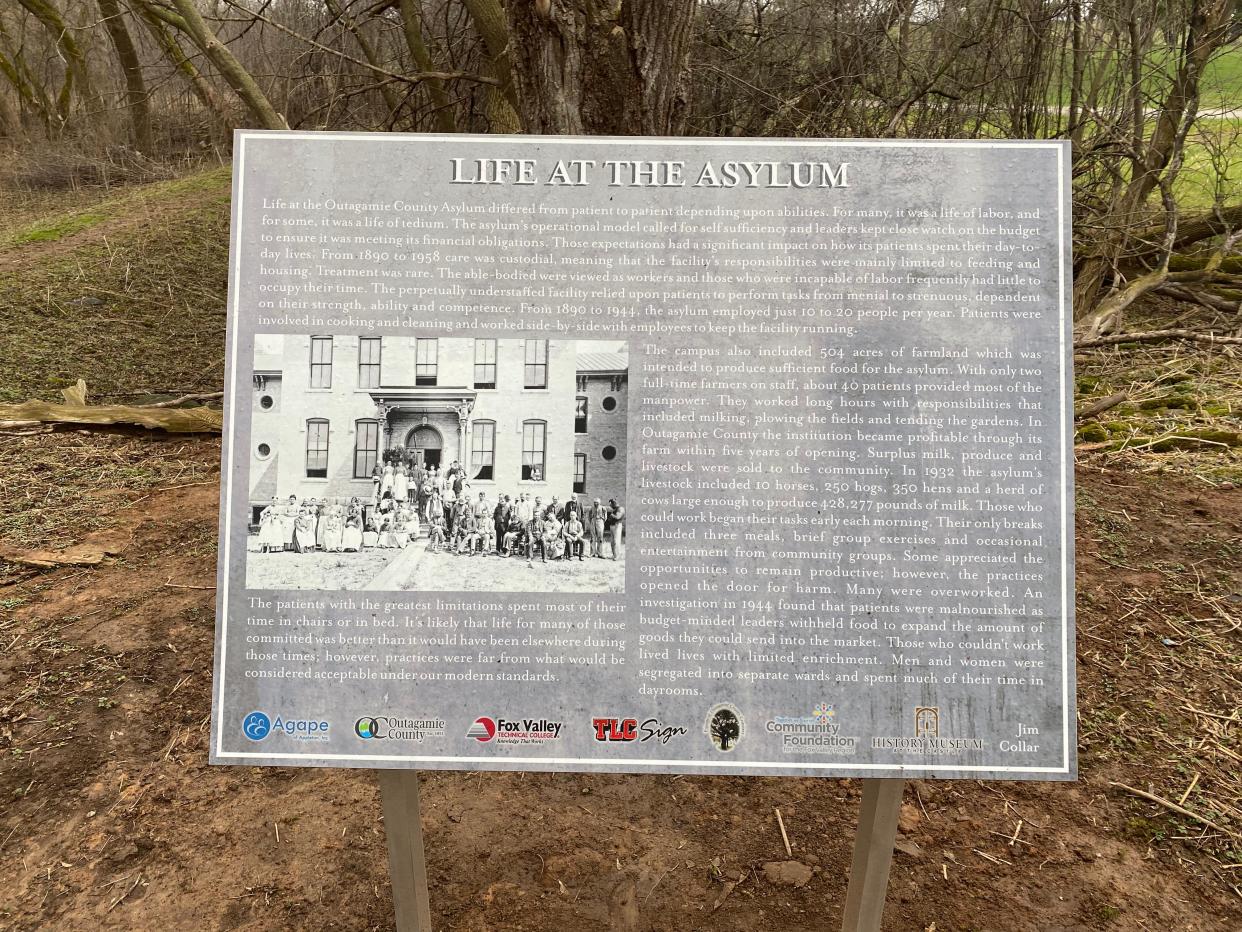The history of the Outagamie County Asylum for the Chronic Insane and its long-forgotten cemetery is told through new storyboards

GRAND CHUTE - Next to the current site of Outagamie County's Brewster Village skilled nursing care center once stood the Outagamie County Asylum for the Chronic Insane.
Opened in 1890, the asylum’s history represents a time of unethical and often-abusive mental health treatment.
Today, all that physically remains of the building is a stone bridge and a cemetery of 133 people unclaimed by families after they died at the asylum.
Nine years ago, a group of volunteers embarked on a project to give those buried there in now-unmarked graves some dignity — and a place in the county’s history.
Recently, that project wrapped up its final stage, with three storyboards installed to give visitors a better understanding of the asylum, life for its residents and the cemetery.
MORE: Historic photos of the Outagamie County Asylum for the Chronic Insane
MORE: Woman shares asylum memories
Reclaiming a forgotten cemetery
Before the volunteers started the project, the cemetery has become became overgrown and was mostly forgotten, apart from a misspelled sign that read “Outagamie County Insane Asylum Cemetary 1891-1943.” The headstones had been removed in the 1970s.
But in 2013, a group of concerned residents and members of Agape of Appleton, a residential support service for individuals with developmental disabilities, started efforts to restore the cemetery.
The volunteers, called the Friends of Outagamie County Cemetery, began working with the county and the Wisconsin Historical Society to rededicate it.
"We really just wanted it to be recognized as a cemetery and to have a little nicer sign," member Laura Shinkan said. "But as the word on the story spread, it became a much larger project."
MORE: Memorial to recognize 'unwanted' at asylum cemetery
MORE: Insane asylum cemetery project progressing
The effort drew a lot of help from people in the community, including Lawrence University Professor Peter Peregrine, who took his anthropology students to scan the grounds to determine the location of the graves in 2014.
Volunteers then matched the burial plots of the 133 men, women and children buried there with the asylum records to identify the people at the site.
Fox Valley Technical College also helped with the rededication by having its landscape construction class create a pathway through the cemetery and build a pergola on the edge of the property.
In 2015, a ceremony was held on the grounds to officially rededicate the cemetery and unveil a granite stone with the names of the 133 individuals buried there.
The project has culminated with the unveiling of the storyboards that tell the life of the people who lived — and died — at the asylum.
Information on the storyboards come from an exhibit the History Museum at the Castle created titled, “Asylum Out of the Shadows.” Jim Collar, a former Post-Crescent reporter who wrote often about the volunteer efforts, wrote the storyboard text.
Besides the Friends group, the project was funded by the Nelson Family Fund in the Community Foundation for the Fox Valley Region and TLC Signs.
Storyboards tell the history of the asylum
The storyboards at the cemetery tell how those committed to the asylum were deemed unable to live with the general population and stayed there the rest of their lives.
Next to the building was a farm that its residents worked on to keep the facility self-sufficient. Able-bodied residents were made to work long hours, milking cows, plowing the fields and tending to the gardens with few breaks.
Those who were unfit for labor were often confined to sit or lay in bed.
In its day, the asylum was a state-of-the-art facility and considered a better alternative than life among the general public for its residents.
The storyboards tell how the asylum operated at a time of limited understanding on mental health and how some residents were committed for homosexuality or alcoholism.
Staff at the asylum weren't adequately trained to help the patients and investigations into the leadership found patient abuse violations.
This final stage of the Outagamie County Cemetery project looks to showcase the people who lived at the asylum and the experiences they had.
“We felt as a community we could do better at remembering those that were vulnerable in society at the time,” Shinkan said. “I think our community proved that we could.”
Sophia Voight is a government watchdog reporter for the Appleton Post-Crescent. She can be reached at svoight@postcrescent.com or 920-993-7102.
This article originally appeared on Appleton Post-Crescent: Outagamie County Asylum for Chronic Insane, cemetery has story told
